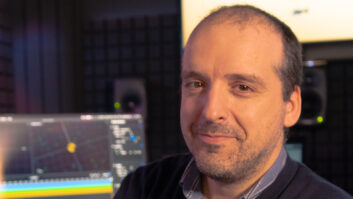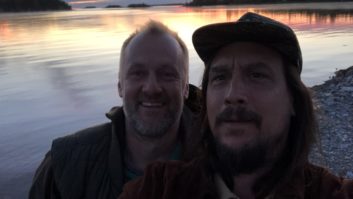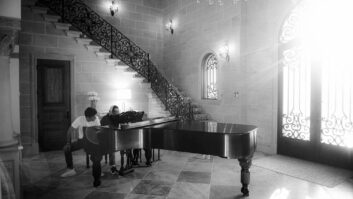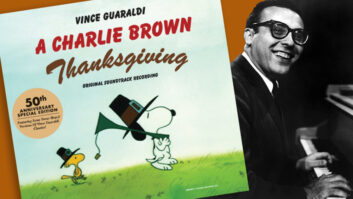
Amplified music, a source of entertainment and joy for millions, has also produced a serious public health problem: hearing impairment caused by listening to music at excessive sound levels. The level at a typical rock concert may approach 120 decibels, or 30 dB more than that required to produce permanent hearing loss, and even a personal stereo may exceed 110 dB. In the face of this growing problem, the Mix Foundation for Excellence in Audio has formed partnerships with organizations that educate both audio professionals and the public about “safe hearing.”

Only a few years ago, when hearing professionals at the House Ear Institute asked people in the audio and music industries if they would consider wearing hearing protection, the response was typically a laugh and a, “Are you kidding? No one worries about that!” Or, more commonly, “Hey, I’m already deaf.”
There now exists a whole generation of professional sound veterans and musicians whose careers began during the early days of loud rock ’n’ roll, and who have suffered irreversible damage to their hearing. But, until recently, they had access to little or no information about the dangerous connection between high-decibel sound exposure and permanent hearing loss. As a result, some of these professionals, now in their 40s and 50s, have a level of hearing loss that affects their ability to communicate.

In a TEC Awards reversal, Charlie Lahaie of the House Ear Institute presents the Mix Foundation with a certificate of appreciation. From left: Lahaie, David Schwartz, Karen Dunn, Hillel Resner and Penny Riker
Sound Partners to the Rescue
It was in this climate that, in 1997, with the support of the Mix Foundation, the House Ear Institute launched its Sound Partners hearing conservation program for audio engineers, musicians and other sound professionals. The program began as an offshoot of an earlier effort developed in 1986, the Institute’s Hearing Is Priceless (HIP) program, whose goal it was to provide teaching aids for elementary school health classes around the country. At that time, Mix, through its foundation, took an active leadership role in the Institute’s educational outreach by designating the HIP program as a major beneficiary of proceeds from the TEC Awards.
During the decade that followed, the HIP program saturated 1,000 school districts across the country with its “HIP Talk” video program and supporting educational tools. Through its support of the HIP program, the Mix Foundation and its industry supporters began to recognize the need to educate their audio industry colleagues about the seriousness and risks of noise-induced hearing loss and what tools were available to protect themselves.

Damaged inner ear cells
Photo: House Ear Institute

Healthy inner ear cells
Photo: House Ear Institute
Building Awareness
In 1997, at the Audio Engineering Society Convention in New York, the House Ear Institute joined with the Mix Foundation to produce the Sound Partners hearing conservation program for audio and music professionals. No other comprehensive program of its kind was available to educate the industry about what had already become a serious and pervasive problem for thousands of industry professionals.
Over the ensuing seven years, the overall awareness level and receptivity to learning about the risks and prevention of noise-induced hearing loss has experienced remarkable changes. Many of the audio professionals, who were at one time quick to dismiss the notion of hearing conservation practices in their work environments, are now among the first to sign up for the free hearing screenings at trade shows and help spread the hearing conservation message to their colleagues. Many return on an annual basis to have their hearing screened at industry trade events.
“The level of awareness among audio professionals about sound exposure and hearing health has grown exponentially since the issue was introduced in earnest to the industry in 1997,” said James D. Boswell, CEO of House Ear Institute. “The Institute recognizes how important hearing conservation education is to those who are working in pro sound, and we continue to broaden our Sound Partners program outreach efforts to ensure this positive educational trend continues.”
The challenge to individuals in recognizing risk to their hearing is compounded by the advances in audio technology. Today’s digital audio allows listeners to turn the volume up without experiencing the same signal distortion that occurred at extreme decibels with analog audio. While everyone benefits from the clearer, cleaner signals, the improvements have blurred the ability to distinguish when loud sound may be too loud for our auditory system to tolerate.

House Ear scientists research the inner ear’s structure
New Study of Audio Pros
This past April, the House Ear Institute announced the findings of the first study of its kind to analyze the impact and prevalence of noise-induced hearing loss within the audio and music industries. The study, conducted by Rachel Cruz, M.A., CCC-A/FAAA, a research audiologist at House Ear Institute, utilized data compiled from thousands of hearing screenings conducted at audio and music industry trade shows over the course of seven years, as part of the Sound Partners program.
The study indicated that high-frequency hearing loss from noise-induced inner ear damage is evident in this sector of the population that is repeatedly exposed to high levels of sound. Even when thresholds were within normal limits, all groups shared a characteristic “noise-notch,” or loss of hearing sensitivity, around the 4 to 6kHz frequency range. The study further confirmed that compared to the general population, both men and women in music and sound careers show more hearing loss across all age groups. This study reinforces the need for a strong hearing conservation educational program and guidelines that industry professionals across the board can apply to their work.
While the program will continue to expand its educational efforts targeting the music and audio professions, the Institute is preparing to launch a multi-tiered public hearing health campaign next year that targets teens and young adults, who also are at significant risk of noise-induced hearing loss, but who lack real awareness of the facts.
Tools for Hearing Health
One of the biggest priorities for Sound Partners in 2005 is to expand the educational information and resources available on its Website, which is becoming an increasingly powerful conduit for hearing conservation information, including downloadable classroom tools.
“Our goal is to offer a comprehensive selection of educational materials on hearing conservation to people wherever they are in the world,” said Boswell. “Whether the need is technical information for the audio professional, class materials for professors to download, or quick facts for the listening public, people will be able to easily find this information, along with many other hearing health topics, directly from our Website at www.hei.org.”
Visitors can already take an online, state-of-the-art hearing test, called the HINT, or try out the hearing loss simulator and get the latest online facts about NIHL (noise-induced hearing loss). An online hearing conservation course is also under development for use by educators and sound industry professionals, and will be available on the Website within the next two months.
Sound Partners also offers a selection of printed materials, including educational brochures, earplugs, hearing conservation fact sheets and wall posters that provide customers and employees with the decibel levels of everyday sound-related activities at a glance. At the same time, Sound Partners continues to increase its visibility and resources at audio and music trade shows and in the news media.
As Sound Partners moves ahead with new outreach opportunities, it is exploring innovative ways for audio industry professionals to become stronger advocates of hearing conservation and the hearing health of the listening public. Log on and visit; your ears will thank you.
To learn how you or your organization can become involved in the Sound Partners hearing conservation program, or for additional educational information, contact Marilee Potthoff, director of marketing and outreach, House Ear Institute at
.







